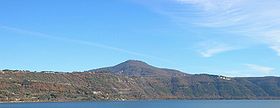Alban hills
| Alban Hills | |
|---|---|
| Colli Albani | |

Monte Cavo (the Alban Mount) and Alban Lake
|
|
| Highest point | |
| Elevation | 950 m (3,120 ft) |
| Prominence | Monte Cavo |
| Coordinates | 41°43′48″N 12°42′00″E / 41.73000°N 12.70000°ECoordinates: 41°43′48″N 12°42′00″E / 41.73000°N 12.70000°E |
| Geography | |
| Geology | |
| Mountain type | Stratovolcano |
| Last eruption | 5,000 BC |
The Alban Hills (Italian Colli Albani) are the site of a quiescent volcanic complex in Italy, located 20 km (12 mi) southeast of Rome and about 24 kilometres (15 mi) north of Anzio.
The dominant peak (but not the highest) is Monte Cavo at 950 m. There are two small calderas which contain lakes, Lago Albano and Lake Nemi. The rock of the hills is called peperino (lapis albanus) a variety of tuff, a combination of volcanic ash and small rocks that is useful for construction, and provides a mineral-rich substrate for vineyards.
The area was inhabited by the Latini during the 5th to 3rd centuries BC. The ancient Romans called them Albanus Mons. On the summit was the sanctuary of Jupiter Latiaris, in which the consuls celebrated the Feriae Latinae, and several generals celebrated victories here during times when they were not accorded regular triumphs in Rome. The foundations and some of the architectural fragments of the temple were still in existence until 1777, when they were used to build the Passionist monastery by Cardinal York, but the Via Triumphalis leading up to it can still be seen.
The hills, especially around the shores of the lakes, have been popular since prehistoric times. From the 9th to 7th century BC, there were numerous villages (see the legendary Alba Longa and Tusculum). In Roman times, these villages were inhabited, often as a way to escape the heat and crowds of Rome, and there are many villas and country houses still present.
...
Wikipedia

